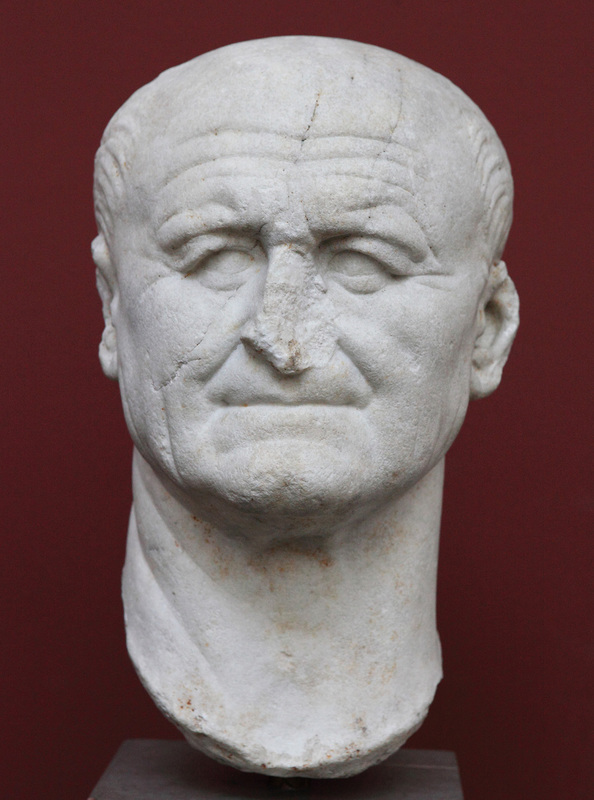Copenhagen Vespasian
Title
Copenhagen Vespasian
Date
Flavian, ca. AD 70-79
Artist or Workshop
Unknown
Materials
Marble
Height of the work
40 cm tall
Provenience
Likely from Naples
Current Location
Ny Carlsberg Glyptotek, Copenhagen, Denmark
Sitter Biography
Vespasian was born in AD 9 to a humble, equestrian family. His early career in the military was marked by numerous successes, leading to his ten year reign as emperor. He came to imperial power in AD 69 during the civil war following the death of Nero. Vespasian’s reign is most notably characterized by his fiscal reforms and consolidation of the empire which led the way to political stability and a vast Roman building program. After his death in 79, he was succeeded by his eldest son Titus, thus becoming the first Roman emperor to be directly succeeded by his own natural son and establishing the Flavian dynasty that would rule over the Roman Empire for 27 years.
Description and Significance
Description:
This marble portrait of Vespasian depicts the Flavian emperor in the veristic style. The sculptor has emphasized Vespasian’s age and experience through the fleshy face, deep-set wrinkles along the forehead and neck, nasolabial lines, and balding head. Many of portraits of the emperor contain distinctive facial features that are evident in this portrait such as, the broad forehead, small, close-set eyes, arched eyebrows, thin lips, and hooked nose. However, the nose of this particular portrait has been broken off, along with parts of the ears. A bronze peg is set into the crown of the head and a hole appears in the nape of the neck, indicating that a wreath once rested on the emperor’s head. The neck has been formed for insertion into a full-body statue.
Significance:
This portrait of Vespasian marks a break with Julio-Claudian portraiture. Its veristic style both references the honored Republican tradition and counters the youthfulness common in the portraits of the emperors who preceded him. This change in style reflects the emperor’s desire to distance himself from the controversial periods of rule that came before him. Vespasian is portrayed modestly, reflecting his popularity among the empire as an “every-man.” He brought wealth into the capital and was successful militarily; this portrait emanates the type of determination he was known for throughout these accomplishments.
This marble portrait of Vespasian depicts the Flavian emperor in the veristic style. The sculptor has emphasized Vespasian’s age and experience through the fleshy face, deep-set wrinkles along the forehead and neck, nasolabial lines, and balding head. Many of portraits of the emperor contain distinctive facial features that are evident in this portrait such as, the broad forehead, small, close-set eyes, arched eyebrows, thin lips, and hooked nose. However, the nose of this particular portrait has been broken off, along with parts of the ears. A bronze peg is set into the crown of the head and a hole appears in the nape of the neck, indicating that a wreath once rested on the emperor’s head. The neck has been formed for insertion into a full-body statue.
Significance:
This portrait of Vespasian marks a break with Julio-Claudian portraiture. Its veristic style both references the honored Republican tradition and counters the youthfulness common in the portraits of the emperors who preceded him. This change in style reflects the emperor’s desire to distance himself from the controversial periods of rule that came before him. Vespasian is portrayed modestly, reflecting his popularity among the empire as an “every-man.” He brought wealth into the capital and was successful militarily; this portrait emanates the type of determination he was known for throughout these accomplishments.
References
Fleming, J. 1995. Catalogue Roman Portraits: Ny Carlsberg Glyptotek, Volume 2, pp. 28-29.
Varner, E. 2000. From Caligula to Constantine: Tyranny and Transformation in Roman Portraiture, Atlanta, pp. 134-139.
Kleiner, D. E. E. 1994. Roman Sculpture, New Haven, pp. 171-177. http://ancientrome.ru/art/artworken/img.htm?id=386
https://www.britannica.com/biography/Vespasian
http://museum.classics.cam.ac.uk/collections/casts/vespasian
Varner, E. 2000. From Caligula to Constantine: Tyranny and Transformation in Roman Portraiture, Atlanta, pp. 134-139.
Kleiner, D. E. E. 1994. Roman Sculpture, New Haven, pp. 171-177. http://ancientrome.ru/art/artworken/img.htm?id=386
https://www.britannica.com/biography/Vespasian
http://museum.classics.cam.ac.uk/collections/casts/vespasian
Contributor
Lauren Kershenbaum
Citation
Unknown, “Copenhagen Vespasian,” Digital Portrait "Basket" - ARTH488A - "Ancient Mediterranean Portraiture", accessed May 20, 2024, https://classicalchopped2.artinterp.org/omeka/items/show/36.
Item Relations
This item has no relations.

